 W
WThe African forest elephant is one of the two living African elephant species. It is native to humid forests in West Africa and the Congo Basin. It is the smallest of the three living elephant species, reaching a shoulder height of 2.4 m. Both sexes have straight, downpointing tusks, which erupt when they are 1–3 years old. It lives in family groups of up to 20 individuals. Since it forages on leaves, seeds, fruit, and tree bark, it has been referred to as the 'megagardener of the forest'. It contributes significantly to maintain the composition and structure of the Guinean Forests of West Africa and the Congolese rainforests.
 W
WThe African golden cat is a wild cat endemic to the rainforests of West and Central Africa. It is threatened due to deforestation and bushmeat hunting and listed as Vulnerable on the IUCN Red List. It is a close relative of both the caracal and the serval. Previously, it was placed in the genus Profelis. Its body size ranges from 61 to 101 cm with a 16 to 46 cm long tail.
 W
WThe golden angwantibo is a strepsirrhine primate of the family Lorisidae. It shares the genus Arctocebus with the Calabar angwantibo and together they are commonly called the golden pottos. The golden angwantibo is found in Cameroon, the Republic of Congo, Equatorial Guinea and Gabon. Its usual habitat is rain forest, but it has also been known to live on farmland.
 W
WBates's pygmy antelope, also known as the dwarf antelope, pygmy antelope or Bates' dwarf antelope, is a very small antelope living in the moist forest and brush of Central and West Africa. It is in the same genus as the suni and the royal antelope.
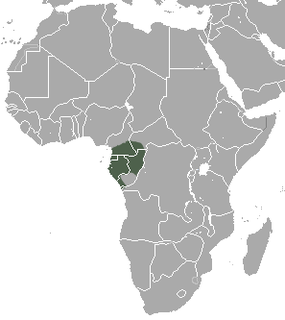 W
WThe southern needle-clawed bushbaby is a species of strepsirrhine primate in the family Galagidae. Found in Cameroon, Central African Republic, Republic of the Congo, and possibly Democratic Republic of the Congo, its natural habitat is tropical moist forests. While the species is not threatened or endangered, some local populations may be threatened by habitat destruction.
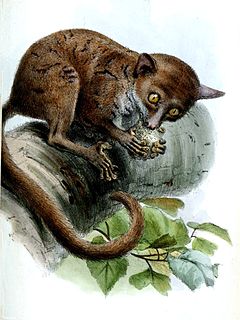 W
WPrince Demidoff's bushbaby, also known as Prince Demidoff's galago, is a species of primate in the family Galagidae. It is native to parts of tropical West and Central Africa.
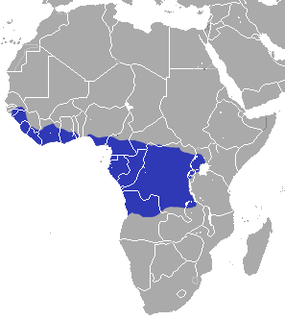 W
WThomas's bushbaby is a species of primate in the family Galagidae. It is found in Angola, Burundi, Cameroon, Democratic Republic of the Congo, Equatorial Guinea, Gabon, Kenya, Nigeria, Rwanda, Tanzania, Uganda, and Zambia.
 W
WThe central chimpanzee or tschego is a subspecies of the common chimpanzee. It occurs mainly in Gabon, Cameroon, and the Republic of the Congo, but also, to a lesser extent, in other regions.
 W
WThe black colobus, or satanic black colobus, is a species of Old World monkey belonging to the genus Colobus. The species is found in a small area of western central Africa. Black colobuses are large, completely covered with black fur, and like all other Colobus monkeys, do not have a thumb. The species has faced large declines in population due to habitat destruction and hunting by humans, and was consequently listed as Vulnerable on the IUCN Red List in 1994.
 W
WPeters's duiker is a small antelope found in Gabon, Equatorial Guinea, southern Cameroon, and northern Republic of the Congo.
 W
WThe white-legged duiker is a medium-sized antelope species from the subfamily of duikers (Cephalophinae) within the family of bovids (Bovidae). It is native to Gabon and the Republic of the Congo. It was described as subspecies of the Ogilby's duiker by Peter Grubb in 1978. After a revision of the ungulates in 2011 by Colin Groves, it is now regarded as distinct species.
 W
WThe Gabon bushbaby is a species of primate in the family Galagidae found in Cameroon, Gabon, and the Republic of the Congo. Its head and body length is 8.5 in with a 10-in tail, and it weighs about 10 oz. It lives in evergreen tropical rainforests and eats primarily fallen fruit, but also some arthropods.
 W
WThe western lowland gorilla is one of two subspecies of the western gorilla that lives in montane, primary and secondary forest and lowland swampland in central Africa in Angola, Cameroon, Central African Republic, Republic of the Congo, Democratic Republic of the Congo, Equatorial Guinea and Gabon. It is the nominate subspecies of the western gorilla, and the smallest of the four gorilla subspecies.
 W
WThe western gorilla is a great ape—the type species as well as the most populous species of the genus Gorilla.
 W
WThe moustached guenon or moustached monkey is a species of primate in the family Cercopithecidae. It is found in Angola, Cameroon, Central African Republic, Republic of the Congo, Democratic Republic of the Congo, Equatorial Guinea, and Gabon.
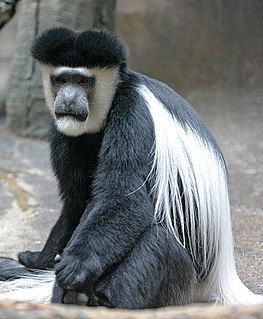 W
WThe mantled guereza, also known simply as the guereza, the eastern black-and-white colobus, or the Abyssinian black-and-white colobus, is a black-and-white colobus, a type of Old World monkey. It is native to much of west central and east Africa, including Cameroon, Equatorial Guinea, Nigeria, Ethiopia, Kenya, Tanzania, Uganda and Chad. The species consists of several subspecies that differ in appearance. It has a distinctive appearance, which is alluded to in its name; the long white fringes of hair that run along each side of its black trunk are known as a mantle. Its face is framed with white hair and it has a large white tail tuft.
 W
WThe red river hog, also known as the bush pig, is a wild member of the pig family living in Africa, with most of its distribution in the Guinean and Congolian forests. It is rarely seen away from rainforests, and generally prefers areas near rivers or swamps.
 W
WThe African manatee, also known as the West African manatee, is a species of manatee that is mostly herbivorous. African manatees inhabit much of the western region of Africa – from Senegal to Angola. Although not a great deal is known about this species, it is hypothesized that the African manatee is very similar to the West Indian manatee.
 W
WThe mandrill is a primate of the Old World monkey (Cercopithecidae) family. It is one of two species assigned to the genus Mandrillus, along with the drill. Both the mandrill and the drill were once classified as baboons in the genus Papio, but they now have their own genus, Mandrillus. Although they look superficially like baboons, they are more closely related to Cercocebus mangabeys. Mandrills are found in southern Cameroon, Gabon, Equatorial Guinea, and Congo. Mandrills mostly live in tropical rainforest and in very large groups. Mandrills have an omnivorous diet consisting mostly of fruits and insects. Their mating season peaks in July to September, with a corresponding birth peak in December to April.
 W
WThe agile mangabey is an Old World monkey of the white-eyelid mangabey group found in swampy forests of Central Africa in Equatorial Guinea, Cameroon, Gabon, Central African Republic, Republic of Congo, and DR Congo. Until 1978, it was considered a subspecies of the Tana River mangabey. More recently, the golden-bellied mangabey has been considered a separate species instead of a subspecies of the agile mangabey.
 W
WThe collared mangabey, also known as the red-capped mangabey, or the white-collared mangabey, is a species of primate in the family Cercopithecidae of Old World monkeys. It formerly included the sooty mangabey as a subspecies. As presently defined, the collared mangabey is monotypic.
 W
WThe grey-cheeked mangabey, also known as the white-cheeked mangabey, is an Old World monkey found in the forests of Central Africa. It ranges from Cameroon down to Gabon. The grey-cheeked mangabey is a dark monkey, looking in shape overall like a small, hairy baboon. Its thick brown fur is almost black in its forest home, with a slightly rufus/golden mane around the neck. The sexes are similar, with the males slightly larger than the females.
 W
WThe black-footed mongoose is a mongoose species native to Central Africa, where it inhabits deep deciduous forests from eastern Nigeria to the southern Democratic Republic of the Congo. It has been listed as Least Concern on the IUCN Red List since 2008. It is omnivorous and feeds on ants, termites, Orthoptera, small rodents, frogs, lizards and fruits. It is mostly solitary and nocturnal.
 W
WThe marsh mongoose is a medium-sized mongoose native to sub-Saharan Africa, where it inhabits foremost freshwater wetlands. It has been listed as Least Concern on the IUCN Red List since 2008.
 W
WDe Brazza's monkey is an Old World monkey endemic to the riverine and swamp forests of central Africa. The largest species in the guenon family, it is one of the most widespread arboreal African primates. Aside from size, it can be differentiated from other cercopithecus monkeys by its orange diadem and white beard. Due to its cryptic nature, the species is not well documented in all of its habitats but has shown unique traits such as pair-bonding and aggressive behavior towards other guenons.
 W
WThe crested mona monkey, also known as the crowned guenon, crowned monkey, golden-bellied guenon, or golden-bellied monkey,, is a species of African primate in the family Cercopithecidae found in west central Africa.
 W
WThe greater spot-nosed monkey or putty-nosed monkey is one of the smallest Old World monkeys. It is a guenon of the C. mitis group, native to West Africa and living to some extent in rain forests, but more often in the transition zone between rain forest and savannah. It is primarily arboreal and often associates with monkeys of other species. Both their common names come from the monkeys' prominent white nose.
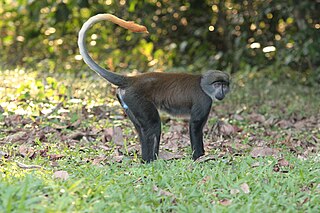 W
WThe sun-tailed monkey from Gabon is one of the least studied primates in its habitat. It was discovered as a new species in 1988, and is classified as a guenon, which is a member of the genus Cercopithecus, but was subsequently moved to the genus Allochrocebus. It is closely related to A. preussi and A. Ihoesti, which has been determined by chromosomal analysis. Sun-tailed monkeys prefer shady areas with dense vegetation. However, even after small amounts of logging activity, populations can be unaffected. Much of their diet remains unknown and is still being studied, but they are known to prefer fruit. Their social groups are made up of one male and multiple females. Generally, the sun-tailed monkey is less aggressive towards related individuals, which is noteworthy because it has been found that, in other primate species, aggression rates towards related individuals are generally as high or higher than aggression rates towards non-related individuals. Within their social groups, individual monkeys show preference for their mothers over their fathers, and are overall less aggressive to other monkeys that they are associated with spatially.
 W
WThe potto is a strepsirrhine primate of the family Lorisidae. It is the only species in the genus Perodicticus. It is also known as Bosman's potto, after Willem Bosman, who described the species in 1704. In some English-speaking parts of Africa, it is called a "softly-softly".
 W
WThe Cameroon scaly-tail, also referred to as the Cameroon anomalure, flightless anomalure or flightless scaly-tail, is a rodent species endemic to West Central Africa. The scientific literature has never reported observations of live individuals. The taxonomic classification of the species has been subject to recent revision.
 W
WBates's shrew is a species of mammal in the family Soricidae. It is found in Cameroon, Republic of the Congo, Equatorial Guinea, and Gabon. Its natural habitat is subtropical or tropical moist lowland forests. This large black shrew was first described by the British zoologist Guy Dollman in 1915, the type locality being the vicinity of the Como River in Gabon. The exact definition of this species is unclear; it is often included in Fraser's musk shrew, or reported as Wimmer's shrew. Its karyotype is 2n=50, FN-76, which is identical to the Nigerian shrew, and the species complex is in need of a thorough revision.
 W
WJohnston's forest shrew is a species of mammal in the family Soricidae found in Burundi, Cameroon, the Central African Republic, the Republic of the Congo, the Democratic Republic of the Congo, Equatorial Guinea, Gabon, Rwanda, Tanzania, and Uganda. Its natural habitats are subtropical or tropical moist lowland forest and subtropical or tropical moist montane forest. It is threatened by habitat loss.
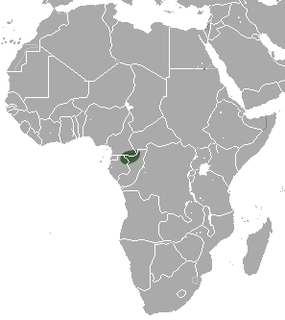 W
WRemy's pygmy shrew is a species of mammal in the family Soricidae. It is found in Cameroon, the Central African Republic, the Republic of the Congo, and Gabon. Its natural habitat is subtropical or tropical moist lowland forests. It is threatened by habitat loss.
 W
WThe sitatunga or marshbuck is a swamp-dwelling antelope found throughout central Africa, centering on the Democratic Republic of the Congo, the Republic of the Congo, Cameroon, parts of Southern Sudan, Equatorial Guinea, Burundi, Ghana, Botswana, Rwanda, Zambia, Gabon, the Central African Republic, Tanzania, Uganda and Kenya. The sitatunga is confined to swampy and marshy habitats. Here they occur in tall and dense vegetation as well as seasonal swamps, marshy clearings in forests, riparian thickets and mangrove swamps.
 W
WThe dwarf scaly-tailed squirrel is a species of rodent in the family Anomaluridae. It is found in Cameroon, Central African Republic, Republic of the Congo, Democratic Republic of the Congo, Equatorial Guinea, Gabon and Uganda. The species is nocturnal and arboreal and lives in subtropical or tropical lowland rainforest. Membranes attached to its limbs and tail enable it to glide between trees. This squirrel is currently not considered to be threatened by habitat destruction; "much of the habitat within parts of the known range of this species is relatively intact, and the species is unlikely to be experiencing any significant declines."
 W
WThe Gabon talapoin, also known as the northern talapoin, is a small species of African monkey in the family Cercopithecidae. It is found in riparian habitats in Cameroon, Equatorial Guinea, Gabon, and western Republic of the Congo and far western Democratic Republic of Congo. It may have been introduced to Fernando Poo and the Canary Islands. Unlike the related Angolan talapoin, the Gabon talapoin has flesh-coloured ears and facial skin.